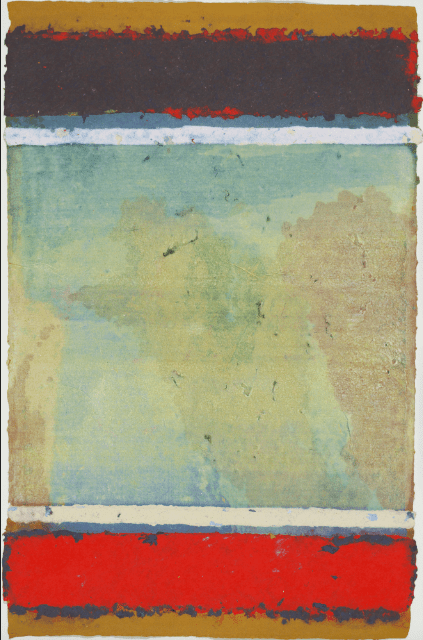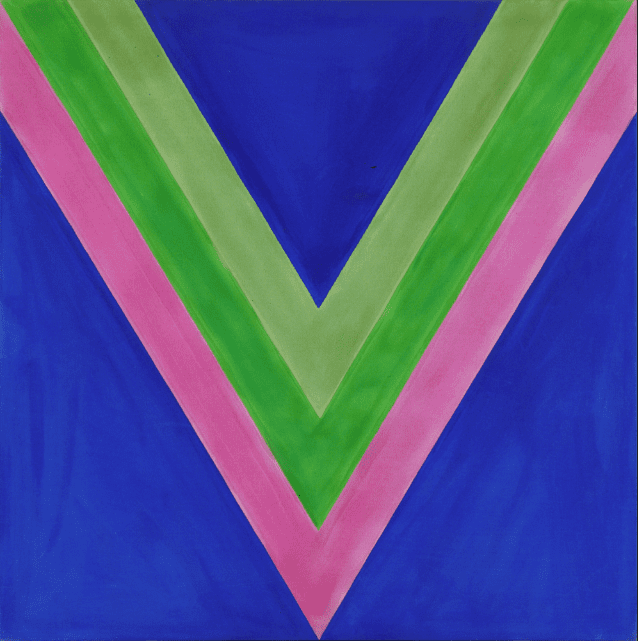
Kenneth Noland
American Artist
1924-2010
Interested in selling a piece by Kenneth Noland?
We have received top dollar for Kenneth Noland works. Auction is the best way to quickly and transparently get maximum dollar for your artwork.

Who is Kenneth Noland? (Prints and Artist Auction Prices)
Kenneth Noland (1924-2010) was an American abstract painter best known for his involvement in Color Field painting. His technique involves adding thin layers of acrylic paint to an unseasoned canvas to create colorful patterns of bullseyes, chevrons, and other geometric forms.
Who is Kenneth Noland? Artist Biography
Kenneth Noland (1924-2010) was born in Asheville, North Carolina on April 10th, 1924. Noland’s father was an amateur painter, so he was able to experiment with painting through childhood. After graduating high school in 1942, Noland enrolled in the Air Force, where he served until 1946. After this, he was able to use the G.I. bill to study at Black Mountain College. Kenneth Noland went on to teach at the Institute of Contemporary Art, as well as several other colleges and universities during the 1950s and 60s.
Kenneth Noland (1924-2010) was born in Asheville, North Carolina on April 10th, 1924. Noland’s father was an amateur painter, so he was able to experiment with painting through childhood. After graduating high school in 1942, Noland enrolled in the Air Force, where he served until 1946. After this, he was able to use the G.I. bill to study at Black Mountain College. Kenneth Noland went on to teach at the Institute of Contemporary Art, as well as several other colleges and universities during the 1950s and 60s.
- Born/Died: April 10, 1924-January 5, 2010
- Nationality: American
- Category: Abstract Art, Color Field Painter
- Related Artists: Helen Frankenthaler, Gene Davis, Morris Lewis
What is the Artist Kenneth Noland Known for?
Kenneth Noland was known as one of the defining artists in Color Field painting. In the 1950s, Noland painted many concentric circles, experimenting with colors and geometry to elicit an emotional response from the viewer. Later on, after he felt he had exhausted painting circles, Noland moved onto other geometric patterns such as diamonds, chevrons, and plaids.
His work was well regarded in his own lifetime, and was shown at a large number of high profile museums, including the Metropolitan Museum of Art, New York; Museum of Modern Art, New York; the Guggenheim, New York; Tate Gallery, London; the Pompidou, Paris, and many more.
What Art Mediums Did Kenneth Noland Use?
Noland’s painting technique was heavily influenced by a visit to the studio of Helen Frankenthaler in 1953, where he observed her technique of staining unprimed canvas with layers of thinned paint. By 1960, this had also become Noland’s primary mode of painting, and he rarely painted with a brush, preferring the cleaner, brushstroke free look of thinned paint poured directly onto the canvas.
In the 1970s and 80s, Noland’s work became further differentiated by his use of shaped canvases. As his technique progressed, he moved from more symmetrical diamonds and chevrons to asymmetrical, many faceted geometric canvas shapes. This strategy served to make the margins of his work feel just as important as the center.
Acrylic Paints
Kenneth Noland most commonly used acrylic paints in his art, preferring their vibrant colors and ease of use. Noland often used unusual and carefully planned color combinations in his geometric compositions, which were further accented by patches of canvas he left entirely blank.
Where Did Kenneth Noland Study Art?
As a recipient of the G.I. bill, Kenneth Noland was able to study for free at Black Mountain College, an experimental arts school just 15 minutes from his hometown. He spent two years at the college, where he was introduced to the fields of geometric abstraction and neo-plasticism by his teachers Ilya Bolotowsky and Josef Albers. After his time there, Noland traveled to France to study under sculptor Ossip Zadkine for one year.
How Did Kenneth Noland Die?
Kenneth Noland died in Port Clyde, Maine on January 5th, 2010 at the age of 85 due to complications of kidney cancer. He was survived by his four children: Cady, Lyndon, William, and Samuel, as well as his fourth wife Paige Rense. In the year following his death, Noland was honored by a solo exhibition of his work at the Guggenheim entitled Kenneth Noland, 1924–2010: A Tribute.
How Much Are Kenneth Noland Prints Worth?
Kenneth Noland’s work has a huge range of value at auction, with the lowest realized price being below $100 and the highest being over $4,000,000. His art has been in demand for decades, and multiple galleries around the country are still currently displaying collections of his work. A testament to his enduring popularity, a record price of $4,255,000 was achieved at auction for his piece “Rocker” in 2021.
His most well known, and most valuable works tend to be acrylic on canvas paintings depicting rings of colorful concentric circles, also called bullseyes. His downward facing chevron forms are also very well liked. In 2021, the average auction price of a Kenneth Noland original was about $7,500, although some pieces far exceed this range.
Kenneth Noland Auction Prices
- Historical auction sales range: $60-$4,255,000
- Average auction estimate for original prints: $1,000-10,000
- Average auction estimate for original paintings: $5,000-100,000
Contact our specialists to learn more about the value of your Kenneth Noland artworks
Valuable Kenneth Noland Paintings and Prints
Here is a collection of valuable Paintings and Prints by artist Kenneth Noland, including examples of many of his often revisited geometric forms, such as bullseyes, chevrons, and stripes.
Kenneth Noland, Diagonal Stripes VI-8
This piece, from Noland’s 1978 diagonal stripes collection, is composed of a series of colored stripes on a blue background. The stripes are made of colored paper pulp pressed onto another sheet of homemade paper.
Estimate: $7,000-$9,000
Result: $17,500
Kenneth Noland, Bridge
This eye-catching acrylic on canvas piece depicts rows of chevrons in contrasting warm and cool tones against a neutral background.
Estimate: $600,000-$800,000
Result: $1,450,000
Kenneth Noland, Beginning
This 1958 acrylic on canvas painting of irregularly shaped red, blue, and black concentric rings is currently held by the Smithsonian museum and has been displayed at several other museums throughout its history.
Kenneth Noland, Trans Flux
This bold acrylic on canvas painting shows a black chevron in between two dark blue chevrons and is an excellent example of Noland’s technique of applying thinned acrylic directly to a canvas.
Estimate: $600,000-$800,000
Result: $1,812,500
Kenneth Noland, Rocker
This acrylic on canvas piece shows a target, or bullseye surrounded by abstract black and red markings. It has commanded the highest auction price of any Kenneth Noland piece to date.
Estimate: $2,000,000-$3,000,000
Result: $4,255,000
Kenneth Noland, Heat
This large acrylic on canvas piece shows a red circle surrounded by increasingly abstract colored rings. It sold for just under $800,000 in 2000, and when it came to auction again in 2015, it sold for $3,370,000, over 400% higher than the previous auction price.
Estimate: $1,500,000-$2,000,000
Result: $3,370,000
Antonio Jacobsen, Racing Schooners (1879)
25’’x42’’ oil on canvas painting of racing schooners from early in Jacobsen’s painting career. Sold in 2011 for over 200% above estimate.
Estimate: $50,000-$70,000
Result: $224,000
Kenneth Noland, Shoot
This acrylic on canvas piece of four chevrons in red, blue, pink, and green is also held by the Smithsonian museum.
Estimate: $50,000-$70,000
Result: $224,000
Kenneth Noland, Turnsole
This striking acrylic on canvas painting shows widely spaced rings in pale blue, black and yellow. It is named after the turnsole flower, which rotates as it grows to face the sun, and was also historically processed into dye for manuscripts. This piece is currently held by the Museum of Modern Art, New York.
Kenneth Noland, Whirl
A lithograph print of a bullseye pattern surrounded by a whirling blue ring. Originally produced as an exhibition poster for “Kenneth Noland: a retrospective” In 1977.
Estimate: $3,450
Result: $3,450
How to Identify a Kenneth Noland Signature
For his canvas paintings, Kenneth Noland would typically sign his name and the date on the back of the canvas in pencil, although he would occasionally sign the front of a piece as well.. For his paper prints, he would typically print the initials “KN” in small raised font on the lower right corner.
How Can I Sell My Kenneth Noland Art?
Kenneth Noland has produced a large number of works over the course of his life, with a wide range of sizes, shapes, and mediums. With final sale prices at auction ranging from several hundred to over a million, it can be hard for an individual to determine how to value their Kenneth Noland painting or print. For this reason, seeking an expert appraisal to determine the authenticity and approximate value of your art is highly recommended.
Revere Auctions Sells Your Kenneth Noland Art
Revere Auctions can help you sell your Kenneth Noland prints or paintings at auction for the best possible price. Our experts at Revere Auctions are ready to help you with any stage of your art journey, whether you are looking for an estimate of value, a USPAP certified appraisal, art restoration, or an effortless way to sell your art. We advertise our sales on more auction platforms than any other auction house in America, and regularly achieve record prices for our objects. If you are interested in selling with us, please reach out for a free auction estimate of your piece today.
Discover Works From Artists Like Kenneth Noland
Helen Frankenthaler
Helen Frankenthaler was an American Abstract Expressionist painter who first introduced Noland to the technique of applying thinned acrylic paint directly onto a canvas.
Gene Davis
Gene Davis was an American Color Field painter famous for his compositions of colorful vertical stripes.
Morris Lewis
Morris Lewis was an important founder of Color Field theory who, along with Noland and Frankenthaler, pioneered the use of Magna (alcohol based acrylics) in their paintings.